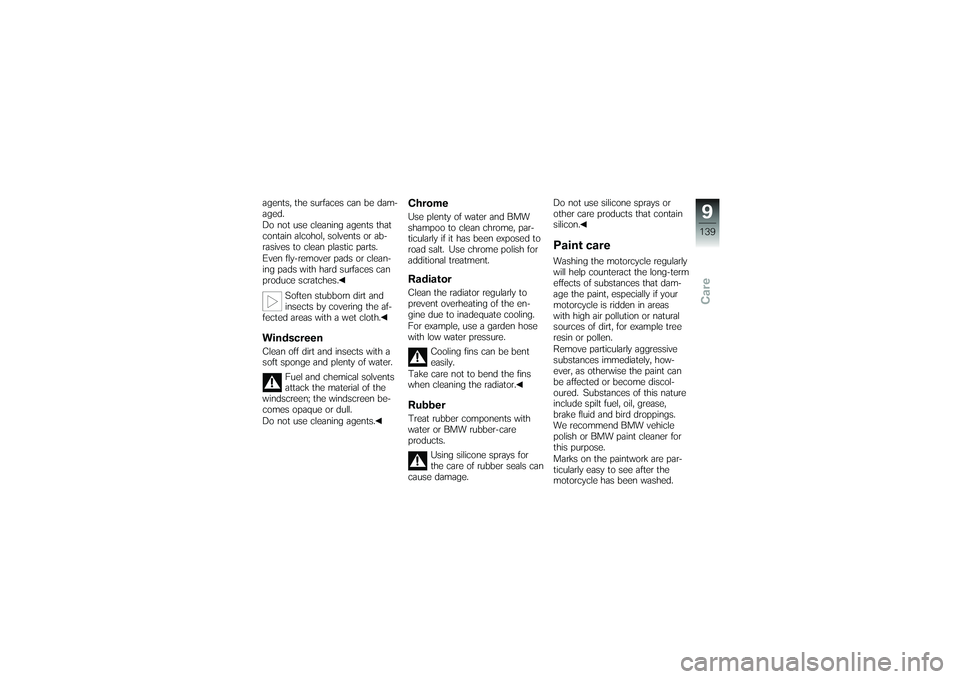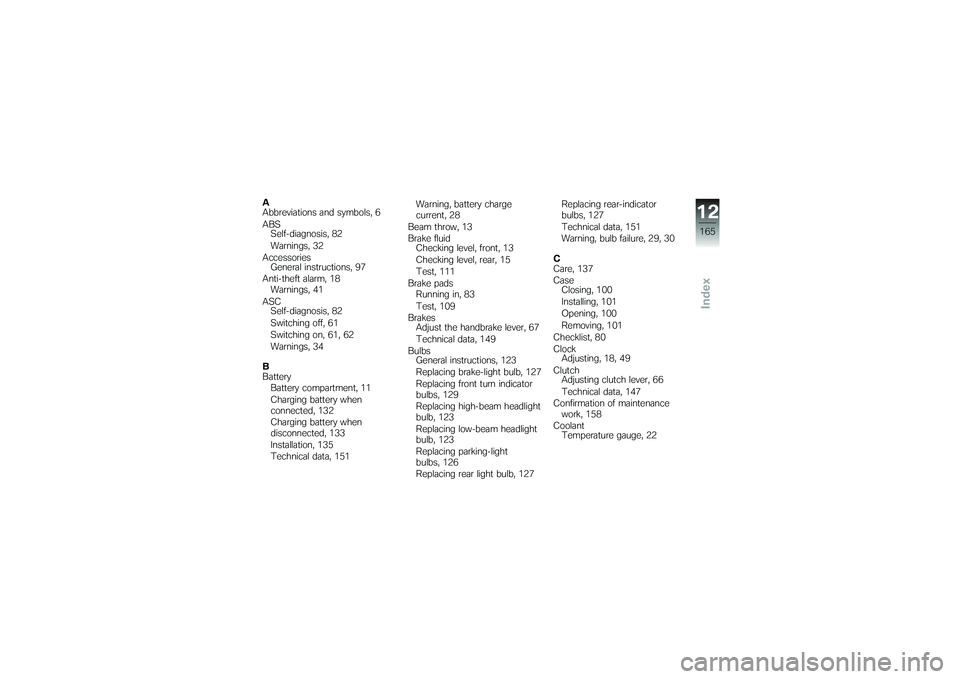Page 112 of 173
Visually inspect the left and
right brake pads to ascertain
their thickness. Viewing direc-
tion: Between wheel and front
fork toward the brake caliper.Brake-pad wear limit,
front
min 1 mm (Friction pad only,
without backing plate)
The wear indicators
(grooves) must be clearly
visible.
If the wear indicating mark is no
longer clearly visible: Have the brake pads replaced
by a specialist workshop,
preferably an authorised BMW
Motorrad dealer.
Checking rear brake pad
thickness
Brake pads worn past
the minimum permissible
brake-pad thickness can cause
a reduction in braking efficiency
and under certain circumstances
they can cause damage to the
brake system.
In order to ensure the dependab-
ility of the brake system, do not
permit the brake pads to wear
past the minimum permissible
brake-pad thickness.
Make sure the ground is level
and firm and place the motor-
cycle on its stand.
8110zMaintenance
Page 113 of 173
Visually inspect the brake pads
from the right to ascertain their
thickness.Brake-pad wear limit, rear
min 1 mm (Wear limit, fric-
tion pad only, without back-
ing plate)
Make sure that the brake
disc is not visible through
the bore in the inboard brake
pad. If the brake disc is visible:
Have the brake pads replaced
by a specialist workshop,
preferably an authorised BMW
Motorrad dealer.
Brake fluidChecking brake-fluid
level, front brakes
A low fluid level in the
brake reservoir can allow air
to penetrate the brake system.
This significantly reduces braking
efficiency.
Check the brake-fluid level at
regular intervals.
Make sure the ground is level
and firm and place the motor-
cycle on its centre stand.
Turn the handlebars once from
full left lock to full right lock
and then centre the handle-
bars. Check the brake fluid level in
brake fluid reservoir
1.
The brake fluid level in the
brake fluid reservoir drops
as the brake pads wear.
8111zMaintenance
Page 114 of 173
Brake fluid level, front
DOT4 brake fluid
Do not permit the brake fluid
level to drop below the MIN
mark. (Brake-fluid reservoir
horizontal. Before reading
the level, swing the handle-
bars once from full left lock
to full right lock.)
If the brake fluid level drops be-
low the permitted level: Have the defect rectified as
quickly as possible by a spe- cialist workshop, preferably
an authorised BMW Motorrad
dealer.
Checking brake-fluid
level, rear brakes
A low fluid level in the
brake reservoir can allow air
to penetrate the brake system.
This significantly reduces braking
efficiency.
Check the brake-fluid level at
regular intervals.
Make sure the ground is level
and firm and place the motor-
cycle on its centre stand. Check the brake fluid level in
brake fluid reservoir
1.
The brake fluid level in the
brake fluid reservoir drops
as the brake pads wear.
8112zMaintenance
Page 117 of 173
Remove screws1on left and
right.
Pull the front mudguard for-
ward to remove. Once the calipers have
been removed, there is
a risk of the brake pads being
pressed together to the extent
that they cannot be slipped back
over the brake disc on reas-
sembly.
Do not operate the handbrake
lever when the brake calipers
have been removed.
Remove securing screws 2of
the left and right brake calipers. Force the brake pads slightly
apart by rocking brake
calipers
3back and forth A
against brake discs 4.
Mask off the parts of the wheel
rim that could be scratched in
the process of removing the
brake calipers.
Carefully pull the brake calipers
back and out until clear of the
brake discs.
When removing the left brake
caliper, take care not to dam-
age the ABS sensor cable.
When removing the right brake
caliper, take care not to alter
8115zMaintenance
Page 140 of 173

Care productsBMW Motorrad recommends
that you use the cleaning and
care products you can obtain
from your authorised BMW Mo-
torrad dealer. The substances in
BMW Care Products have been
tested in laboratories and in prac-
tice; they provide optimised care
and protection for the materials
used in your vehicle.The use of unsuitable
cleaning and care products
can damage vehicle components.
Do not use solvents such as cel-
lulose thinners, cold cleaners,
fuel or the like, and do not use
cleaning products that contain
alcohol.Washing motorcycleBMW Motorrad recommends
that you use BMW insect re-
mover to soften and wash off
insects and stubborn dirt on painted parts prior to washing
the motorcycle.
To prevent stains, do not wash
the motorcycle immediately after
it has been exposed to strong
sunlight and do not wash it in the
sun.
Make sure that the motorcycle
is washed frequently, especially
during the winter months.
To remove road salt, clean the
motorcycle with cold water im-
mediately after every trip.
After the motorcycle has
been washed, ridden
through water or ridden in
the rain, the brake discs and
pads might be wet and the
brakes might not take effect
immediately.
Apply the brakes in good time
until the brakes have dried out.
Warm water intensifies the
effect of salt. Use only cold water to wash off
road salt.
The high pressure of steam
cleaners can damage seals,
the hydraulic brake system, the
electrical system, and the seat.
Do not use a steam jet or high-
pressure cleaning equipment.
Cleaning easily
damaged componentsPlasticsClean plastic parts with water
and BMW plastic care emulsion.
This includes in particular:
Windscreen and slipstream de-
flectors
Headlight lens made of plastic
Glass cover of the instrument
cluster
Black, unpainted parts
If plastic parts are cleaned
using unsuitable cleaning
9138zCare
Page 141 of 173

agents, the surfaces can be dam-
aged.
Do not use cleaning agents that
contain alcohol, solvents or ab-
rasives to clean plastic parts.
Even fly-remover pads or clean-
ing pads with hard surfaces can
produce scratches.Soften stubborn dirt and
insects by covering the af-
fected areas with a wet cloth.WindscreenClean off dirt and insects with a
soft sponge and plenty of water.
Fuel and chemical solvents
attack the material of the
windscreen; the windscreen be-
comes opaque or dull.
Do not use cleaning agents.
ChromeUse plenty of water and BMW
shampoo to clean chrome, par-
ticularly if it has been exposed to
road salt. Use chrome polish for
additional treatment.RadiatorClean the radiator regularly to
prevent overheating of the en-
gine due to inadequate cooling.
For example, use a garden hose
with low water pressure.
Cooling fins can be bent
easily.
Take care not to bend the fins
when cleaning the radiator.RubberTreat rubber components with
water or BMW rubber-care
products.
Using silicone sprays for
the care of rubber seals can
cause damage. Do not use silicone sprays or
other care products that contain
silicon.
Paint careWashing the motorcycle regularly
will help counteract the long-term
effects of substances that dam-
age the paint, especially if your
motorcycle is ridden in areas
with high air pollution or natural
sources of dirt, for example tree
resin or pollen.
Remove particularly aggressive
substances immediately, how-
ever, as otherwise the paint can
be affected or become discol-
oured. Substances of this nature
include spilt fuel, oil, grease,
brake fluid and bird droppings.
We recommend BMW vehicle
polish or BMW paint cleaner for
this purpose.
Marks on the paintwork are par-
ticularly easy to see after the
motorcycle has been washed.
9139zCare
Page 167 of 173

A
Abbreviations and symbols, 6
ABSSelf-diagnosis, 82
Warnings, 32
Accessories General instructions, 97
Anti-theft alarm, 18 Warnings, 41
ASC Self-diagnosis, 82
Switching off, 61
Switching on, 61, 62
Warnings, 34
B
Battery Battery compartment, 11
Charging battery when
connected, 132
Charging battery when
disconnected, 133
Installation, 135
Technical data, 151 Warning, battery charge
current, 28
Beam throw, 13
Brake fluid Checking level, front, 13
Checking level, rear, 15
Test, 111
Brake pads Running in, 83
Test, 109
Brakes Adjust the handbrake lever, 67
Technical data, 149
Bulbs General instructions, 123
Replacing brake-light bulb, 127
Replacing front turn indicator
bulbs, 129
Replacing high-beam headlight
bulb, 123
Replacing low-beam headlight
bulb, 123
Replacing parking-light
bulbs, 126
Replacing rear light bulb, 127 Replacing rear-indicator
bulbs, 127
Technical data, 151
Warning, bulb failure, 29, 30
C
Care, 137
Case Closing, 100
Installing, 101
Opening, 100
Removing, 101
Checklist, 80
Clock Adjusting, 18, 49
Clutch Adjusting clutch lever, 66
Technical data, 147
Confirmation of maintenance work, 158
Coolant Temperature gauge, 22
12165zIndex